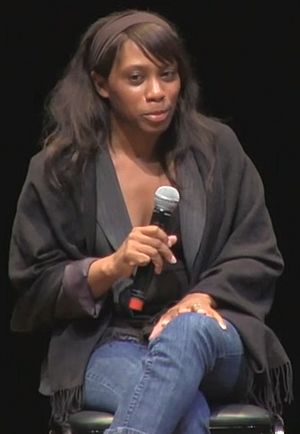Kirsten Greenidge facts for kids
Quick facts for kids
Kirsten Greenidge
|
|
|---|---|
 |
|
| Education | Wesleyan University (BA) University of Iowa (MFA) |
Kirsten Greenidge is an American playwright, which means she writes plays for the theater. Her plays are famous for feeling real and for talking about important social topics. These topics often include how race, gender, and social class connect. Kirsten has two sisters who are also writers: Kerri Greenidge, a historian, and Kaitlyn Greenidge, a writer.
Contents
Kirsten Greenidge's Journey as a Playwright
Kirsten Greenidge decided to become a playwright when she was 12 years old. This happened after she saw a play called Joe Turner's Come and Gone by August Wilson. She studied at Wesleyan University and then at the University of Iowa's Playwright Workshop.
Early Career and Residencies
From 2007 to 2009, Kirsten was a Playwriting Fellow at the Huntington Theatre Company. She was also a Resident Playwright at New Dramatists in New York City from 2006 to 2013. These programs helped her develop her writing skills.
Teaching and Leadership Roles
Kirsten Greenidge is currently an associate professor at Boston University. She teaches playwriting there and helps college students learn about theater. In 2016, she started a three-year role as the Playwright in Residence at Boston's Company One Theatre. This program was supported by the Andrew W. Mellon Foundation. In 2024, Kirsten Greenidge was named the director of the School of Theater at Boston University. This shows her important role in theater education.
Notable Plays by Kirsten Greenidge
Kirsten Greenidge has written several well-known plays. Each one explores different ideas and challenges.
Milk Like Sugar
Milk Like Sugar is a play about growing up. It tells the story of Annie, a 16-year-old girl. She and her friends make a "pregnancy pact." Annie dreams of having a baby and a happy life. But she soon learns that being a teen parent is much harder than she imagined.
The play opened in New York City on October 13, 2011. It was directed by Rebecca Taichman. The play won two important awards in 2012. These were an Obie Award for Playwriting and a Lucille Lortel Award for Outstanding Featured Actress. Kirsten Greenidge was partly inspired by news stories from 2008. These stories were about a "pregnancy pact" at Gloucester High School. Greenidge wanted to show different experiences for young Black women in her play.
Luck of the Irish
Luck of the Irish is about an African American family. In the 1950s, an Irish couple bought their house. But the family later finds out the ownership papers might not have been properly transferred. The family must now find the original deed. They need to convince the couple not to take their home. Otherwise, they risk losing their house.
The play first premiered in March 2012 at the Huntington Theatre Company. It was later shown in New York City at the Lincoln Center in 2013.
Baltimore
Kirsten Greenidge was asked to write Baltimore in 2014. This play is set on a college campus. After a hurtful racial word is written on a student's door, the whole campus starts talking about race. The play explores issues like microaggressions. These are small, everyday actions or words that can be hurtful to people from minority groups. It also discusses racial color blindness and social separation. The play features a diverse cast of characters.
Baltimore was first developed at the University of Maryland. It was then performed in February 2016 at Boston University.
Greater Good (2019)
Greater Good was produced by Company One Theatre in Boston in 2019. The play takes place inside a private school. It shows problems within the school system. These problems include teachers not being paid enough and other issues. The audience moves through the school building during the play. They see different scenes and interact with the story. This play is unique because the audience experiences scenes in different orders.

